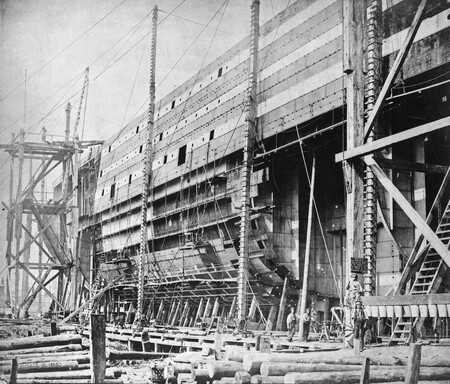Humans have been designing and building boats for centuries. From small carved pieces of wood, such as the Pesse canoe created during the Mesolithic, to authentic floating cities with capacity for thousands of people, such as the enormous Icon of the Seas cruise ship from Royal Caribbean. However, it was not until the 15th century that maritime transport took a substantial leap with the appearance of The Caravelwhich allowed ocean voyages, could even sail against the wind.
Since then, ships have evolved considerably. In the mid-19th century, an English engineer named Isambard Kingdom Brunel, known for being a relevant figure in the Industrial Revolution, He thought about building a steamship so large that it could sail vast distances without the need to refuel with coal. Not only would the vessel carry a large number of passengers, it would also be a key element in England’s dominance of freight transport.
Brunel needed partners to develop this ambitious project, so he shared his idea with John Scott Russell, a renowned naval architect and shipbuilder of the time. Before providing a response, Russell carefully analysed Brunel’s initiative and came to the conclusion that it was a a viable projectStudying every movement was very important because the foundations were being laid for what would be the largest ship ever built, and which would also be tremendously expensive.
Work began with the laying of the keel plate in 1854 at John Scott Russell’s Millwall shipyard on the Thames. The hull was entirely forged in iron and was of a “double skin”, an innovative feature that 100 years later became an industry standard. For propulsion, the ship would feature a combination of a single propeller and paddlewheels. The latter gave the ship a very distinctive appearance. Rigged sails would also be installed on six masts.
Once much of the work was completed, The launch was scheduled for November 3, 1857.. But the enormous size of the ship, originally named Leviathan, triggered a variety of problems. A launch event was organized with a crowd of people and prominent guests. On the day of the launch, however, the ship was got stucktwo workers died and others were injured. Because of this, the launching was rescheduled for months later.

Great Eastern in its construction phase
For the second attempt, the Eastern Steam Navigation Company and its backers arranged for a number of hydraulic rams and windlasses to aid the task. After a failed attempt due to strong winds, the ship was finally launched on the morning of 30 January 1858, although things were somewhat different from how Brunel had imagined. The ship still needed to be fitted out, but the shipbuilding company had fallen into severe financial trouble.
This situation led to the sale of the huge ship. Now in the hands of the Great Eastern Ship Company, it was no longer called Leviathan and was christened Great Eastern. Brunel made a final inspection visit on 5 September 1859, the day on which collapsed on board the ship that had created after suffering a stroke and died ten days laterThe ship, somewhat cursed, suffered an explosion in one of the boiler compartments. That event claimed the lives of several firefighters.


Great Eastern on Southampton Water in 1860
The ship’s problems continued, mainly stemming from its enormity. Very few ports or piers in the world could compete with your size. Among them was the port of Portland.which was the largest in the world, and the New York. When she first arrived at the latter, however, she ended up causing structural damage. The Great Eastern never frequently sailed the routes that Brunel had envisioned and had a short life as a transatlantic passenger transport.

Curiously, this promising 211-meter-long ship, which had been imagined as a piece that could revolutionize maritime transport, was sold for a fraction of its cost. Cyrus West Field, a submarine cable company, used it to lay the first telegraph cable to AmericaAfter several attempts to convert her back into a passenger liner, she was transformed into a showboat for concerts and other activities. Finally, in 1889, the process of scrapping began.
Images | George Washington Wilson | Charles Parsons | National Maritime Museum
At Xataka | The 270 million euro megayacht that has made a Spanish city one of its favorite destinations: Malaga





![[Img #74662]](https://thelatestnews.world/wp-content/uploads/2024/12/Organisms-with-the-shortest-life-150x150.jpg)







![[Img #74662]](https://thelatestnews.world/wp-content/uploads/2024/12/Organisms-with-the-shortest-life-300x200.jpg)


Add Comment